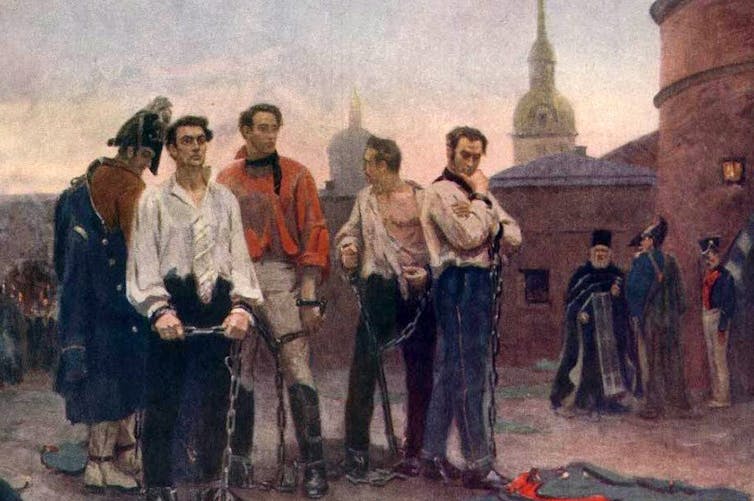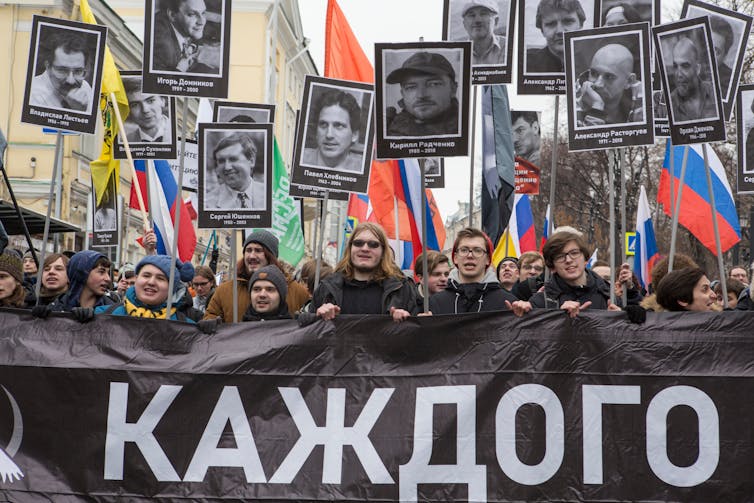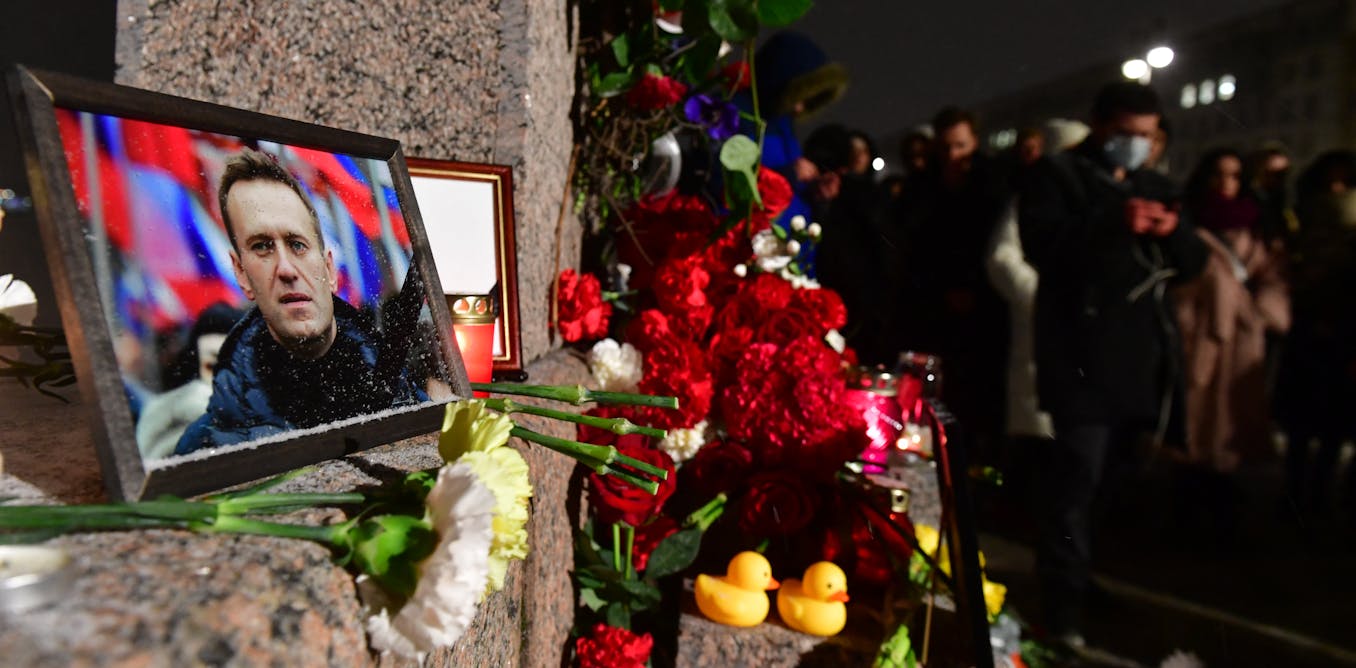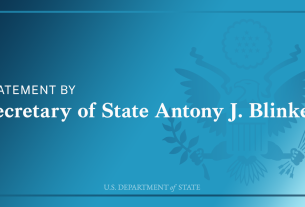|
Getting your Trinity Audio player ready...
|
Since the news of Alexei Navalny’s death broke on Friday 16 February 2024, a good deal of analysts and journalists have taken to framing it in terms of sacrifice and martyrdom.
To the best of our knowledge, there is nothing to suggest that the Russian dissident was driven by any sense of “morbid enjoyment”. Baptised, he described himself as a “typical post-Soviet believer”. And yet, having survived an attempted Novitchok poisoning, he was also fully aware of the risks he was taking when he returned to Russia in January 2021. Were he to be killed, he had said his death would be a testament to the strength of his movement.
The Russian ideal of self-sacrifice
Navalny’s return to Russia can be explained by political considerations – namely, his refusal to go into permanent exile, as the Russian regime wanted. But insofar as he knew the risks to which he was exposing himself, his death – whether the result of “accidental” ill-treatment or an assassination in due form – can be understood as self-sacrifice.
The phenomenon of martyrdom – particularly political martyrdom – is obviously not unique to Russia. To regard it as an intrinsic component of a supposed “Slavic soul” is, in my view, a Western fantasy. That said, martyrdom and suffering occupy an essential place in Russian history and culture.
From autocracy to communism, Russia has throughout history experienced eminently repressive political regimes, often one after the next. The serfdom of a large section of the population until 1861, as well as the military’s critical role in bloody colonisation campaigns, have further helped to forge a culture of suffering as a way of life. Such a Russian ideal is marvellously illustrated by the works of Dostoevsky, Anna Akhmatova and Vasily Grossman – a list that is far from exhaustive. In fact, the etymology of the Russian word moutchenik (martyr) is “suffering” (muka), whereas in French or English, for example, “martyr” comes from the Greek martus, “witness”.
However, Russia’s singularity has less to do with the existence of a culture of sacrifice in defiance toward authorities, which I name here “defiant sacrifice”, than in a specific tension between it and sacrifice in the name of the State between “martyrs” on the one hand and patriotic “heroes” on the other. Understanding this dual culture of sacrifice can help us better grasp Navalny’s tragic fate.
The martyr factory
The first culture of “defiant sacrifice” comprises several historical layers, the oldest of which is religious. Russia’s orthodox Christianity is indeed based on the life and death of the saints, while the country is also marked by the repression of dissident religious movements.
The best-known example of the latter is that of the Old Believers, who opposed the reform undertaken by Patriarch Nikon in the mid-17th century to bring the Russian Orthodox Church into line with the Greek Church. The contested reform ultimately led to a schism within the Orthodox community, the Raskol. Convinced that the disappearance of the traditional Church marked the beginning of the reign of the Antichrist, the Old Believers often set themselves on fire to oppose authorities, whom they perceived as corrupt.
Wikimedia
But Russia’s culture of sacrifice also extends to politics. In 1830-1840, the sociological stratum of the intelligentsia emerges. The individuals constituting it are educated, but above all driven by political ideals inspired by the Age of Enlightenment.
On the death of Alexander Ier in December 1825, a group of officers, the “Decembrists”, demanded an end to the autocracy, with the view of ushering in a constitutional monarchy. The uprising, which saw its leaders executed, paved the way for what came to be known as the “revolutionary martyrs” from the second half of the 19th century onwards.

Wikimedia
Their example nurtured several generations of opponents, right up to the generation of those who chose the path of violence. One of their heiresses was Sophia Perovskaya, who helped orchestrate the assassination of Tsar Alexander II in 1881 and was the only woman executed during Tsarism for a political crime. She, too, knew full well what price she might pay for her act.
Read more:
Ces femmes qui ont fait la révolution russe
The third dimension of Russian self-sacrifice was forged in the Soviet era, and is both religious and political in nature. Two groups stand out: the martyrs of the faith, including members of the Orthodox Church or other religious sects such as Jehovah’s Witnesses, whose martyrdom has a fairly limited influence. On the other, the historian can also note “liberal” dissidents, whose action has contributed to the emergence of a public diplomacy based on suffering – a phenomenon not seen since the tsars’ anti-Semitic policies provoked a crisis between Russia and the United States in the early 20th century.
Examples include the seven Soviets who defied the KGB on 25 August 1968, demonstrating in Moscow against the invasion of Czechoslovakia; the physicist Andrei Sakharov, placed under house arrest in 1980 for openly denouncing the invasion of Afghanistan and the hunt for dissidents; or Anatoly Marchenko, whose death in a prison camp in December 1986 prompted Gorbachev to free Sakharov and extend his glasnost policy.
All knew perfectly well that by speaking out against the Soviet state they were exposing themselves to immense risks, but felt that the cost of inaction would have been higher.
The factory of heroes
This defiant self-sacrifice coexists in Russian political culture with another type of self-sacrifice, this time in defence of the Russian and Soviet state.
Weaponising the past toward political ends is absolutely central to what appears to be a process of heroisation through sacrifice, even if its impact on the population remains difficult to quantify. The history of this process is linked to the emergence of Russia as an ideological entity in the 16th century, as ideas such of Moscow as the “third Rome” and “Holy Russia” gain ground. Throughout the centuries, Russians are brought up on the idea of “Mother Russia” (Rodina), which carves out a sacred homeland which must be defended at all costs.
Navalny’s death and Russia’s future
In her book on the making of martyrs in Russia, American civilisation scholar, Yuliya Minkova, describes the pervasiveness in Putin’s Russia of this phenomenon inherited from Stalinism, and the enduring tension between heroes of resistance and heroes of power.
Initially, during the years 2000-2014, a moderate Putinism had succeeded in defusing the risk of the emergence of martyrs who could have posed a risk to those in power. The first figure to bear the brunt of the repression, the oil tycoon Mikhail Khodorkovsky, was imprisoned between 2003 and 2013 following an eminently political trial, and had come to embody a Putin martyr during those years.
Khodorkovsky could have continued to languish behind bars had he not been pardoned by the president in December 2013. One of the reasons for his release was the death in prison in November 2009 of Sergei Magnitsky, an accountant who uncovered large-scale embezzlement while he was working for an American businessman, Bill Browder. Khodorkovsky’s new freedom worked in Putin’s favour, as the former businessman, exiled in London, lost his aura of “messiah” and dashed the hopes of uniting the opposition.
The Putin regime’s headlong rush after the annexation of Crimea in 2014 was accompanied by a confrontation unprecedented since the Cold War era between the defiant martyrs and patriotic heroes. Nowhere is this more visible than in the annual tussle between Russian progressives coming to lay flowers at the site where renowned opposition figure, Boris Nemtsov, was assassinated in 2015, and the authorities removing them.

limipix/Shutterstock
Let’s not forget that Putin’s immediate justification for invading Ukraine was the need to prevent the “genocide” of the Russian-speaking population of Donbass, victims of a Ukrainian regime described as “Nazi”. Imaginary martyrs, such as the child supposedly crucified by Ukrainian forces, had been invented to encourage Russian soldiers to sign up in the name of a noble cause, and then, later, to respond to the call for mobilisation.
For a long time, Putin’s government had succeeded in limiting Navalny’s influence, going to great lengths to deny his very existence. Putin’s refusal to name him or, for days, of returning his body to his family was part of that strategy. By having him killed, the Russian leader has confirmed Navalny’s status as a martyr in the eyes of a section of the population – those who have not been “zombified” by propaganda and conspiracy theories about links between Navalny and the CIA – and at the same time, the criminal nature of the Russian regime.
Far from erasing Navalny’s message, Putin has on the contrary amplified it, undermining the effect of his own propaganda and undermining the already slim chances of a negotiated solution to the conflict in Ukraine: Navalny’s death has further strained relations between Russia and the West. His widow, Yulia, has announced her intention to take up her husband’s torch. It remains to be seen whether she will be able to give substance to his project, “The marvellous Russia of the future”, so that his sacrifice will not have been in vain.
One thing appears to be certain: the courage of the thousands of mourners who came to Navalny’s funeral on 1 March only reinforced the existing tension between the culture of heroes as martyrs, who sacrifice themselves for Russia’s democratic future, and the culture of heroes as combatants of the “special military operation”.



